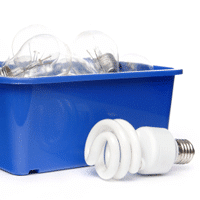Energy-Efficient Light Bulbs Affected by Uncertainty in Washington and at Home
 The debate over energy-efficient light bulbs is heating up.
The debate over energy-efficient light bulbs is heating up.
When compact fluorescent light (CFL) bulbs hit mainstream America several years ago, consumers responded favorably. Incandescent light bulbs, one of the world’s great inventions, had undergone few changes since being patented by Thomas Edison 131 years ago and consumers seemed to like the idea of having the option of spending more in the short-term for significantly longer-lasting light bulbs that could help reduce electric bill costs. Energy-efficient light bulbs were on the rise.
Then, when the Energy Independence and Security Act (EISA) of 2007 was passed during the George W. Bush administration in order to promote, among other things, national energy savings through energy-efficient lighting, incandescent light bulbs really seemed like they were headed out the door. The act required a 25 percent increase in energy efficiency for most standard consumer light bulbs beginning in 2012 and phased out traditional incandescent bulbs over two years until they were removed from store shelves in 2014. The fate of incandescent light bulbs was assured.
But earlier this year, U.S. House Republicans suddenly had a change of heart about the death of the incandescent light bulb. In January, Rep. Joe Barton sponsored legislation that sought to repeal EISA, claiming the act to be a case of government overreach. When Barton’s proposed Better Use of Light Bulbs Act failed to pass the House on July 14, Rep. Michael Burgess, a Republican from Lewisville, introduced an amendment the following day to the Energy and Water Appropriations Act of 2012 that denies funding for the implementation of EISA. Burgess’ amendment passed the House, leaving the future of incandescent bulbs somewhat in limbo as the political debate over them continues.
5 Tips for Choosing the Right Energy-Efficient Light Bulb
Not only is the fate of incandescent bulbs undecided in Washington, but it’s also seemingly undecided in U.S. homes. Some consumers still prefer incandescent bulbs because of performance issues or up-front costs, while other consumers who want to switch to energy-efficient light bulbs may be confused by the choice they have between CFL bulbs, light-emitting diodes (LEDs), and halogen incandescent bulbs.
Rachel Rothman, a consumer electronics and engineering senior test engineer at the Good Housekeeping Research Institute, says that the first thing consumers need to understand about energy-efficient light bulbs is that many of the old concerns surrounding those manufactured before 2008, including performance issues such as off-lighting or light patterns, are no longer problems. To help consumers decide on which energy-efficient light bulb to use, Rothman offers up these five tips:
1. CFL bulbs might be the best all-around option.
New compact fluorescent light bulbs use about 75 percent less energy than incandescent bulbs and they last about 10 times as long. The result is that they can pay for themselves in less than a year. The old spiral shape of the bulb is mostly gone now, replaced by CFLs made in the familiar bulb shape. CFLs are available in a wide range of colors, from whites to yellows. But there are some drawbacks. Not all work with dimmer switches and the bulbs contain small amounts of mercury, which requires significant caution in case of breakage.
2. LEDs save the most energy but cost the most, too.
Light-emitting diodes use up to 80 percent less energy than incandescent bulbs but can cost significantly more up to $50 in some cases although prices are continuing to fall. However, if estimates are correct, LEDs can last about 25 times longer than incandescent bulbs and about 2.5 times longer than CFL bulbs.
3. Halogen incandescent bulbs cost the least but save the least amount of energy.
Traditional incandescent bulbs are filled with inert gas but halogen incandescent bulbs are filled with halogen gas, which allows them to operate at higher temperatures and with brighter light and allows them to last three times longer. Although halogen incandescents use only about 25 percent less energy than traditional incandescents, they have the lowest upfront cost, the widest variety of shapes and colors, and work with dimmer switches.
4. Dont be confused by watts.
When looking at energy-efficient light bulbs, pay attention to the lumens, not the watts. Watts tells you how much energy a bulb uses, not how bright it is. For brightness, look at lumens. A 60-watt incandescent bulb produces about 800 lumens, a brightness that can be matched by a 15-watt CFL bulb.
5. Read labels carefully.
Labels on energy-efficient light bulbs are important. They’ll tell you everything you need to know, including if the bulb is Energy Star’ certified, how bright it is (rated in lumens), how much energy it uses (rated in watts), the appearance of the light (from cool blue to white to warm yellow), the lifespan of the bulb and its estimated annual energy cost (both based on using the bulb for three hours a day) and disposal instructions for bulbs containing mercury.
Sources
Thomas Edison’s Bulb Set to Disappear by Next Year, Anderson Independent Mail, Jan. 17, 2011.
Can Energy-Efficient CFL Bulbs Walk The Green Walk? Seattle Post-Intelligencer, Jan. 19, 2011.
Will the House Turn Out the Lights on Rep. Joe Barton’s Light Bulb Bill? The Houston Chronicle, July 12, 2011.
Rep. Michael Burgess Gives New Light to Joe Barton’s Bulb Bill, The Houston Chronicle, July 14, 2011.
Light Years Ahead, The Houston Chronicle, July 23, 2011.



